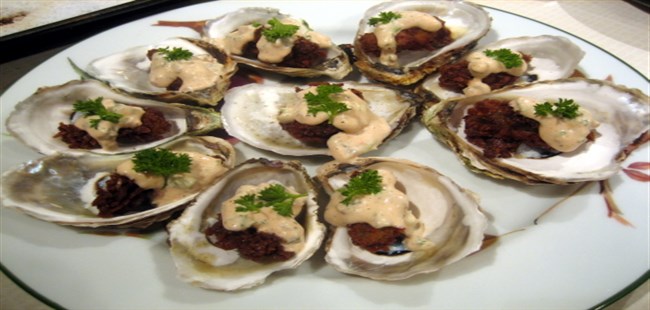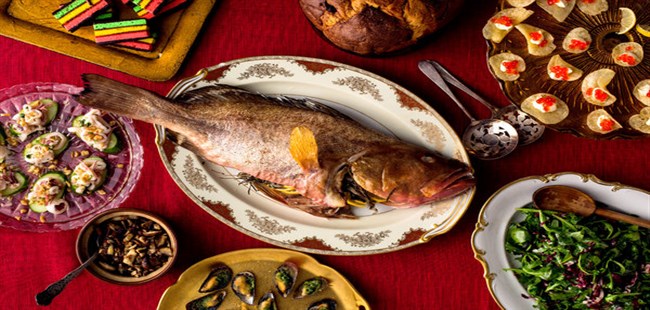Fish cooks simply and quickly, and in its many forms, it can be cooked by most methods. Whole fish cooked on the bone has the best flavor. Filleted fish is versatile enough to be fried, poached, grilled, or even barbecued.
Adding Flavor
Most types of fresh fish need little flavor enhancement, but it is a good idea to use different accents to stimulate appetite and add variety. With a squeeze of lemon and a sprinkling of herbs, or with unusual marinades or glazes, fish can take on new dimensions.
Flavoring Oil
Adding fresh ginger: Before shallow-frying or stir-frying fish, add a few thin slices of fresh ginger to the oil for extra flavor. Stir over medium heat for 3-4 minutes, then remove, and cook the fish.
Flavoring Fish
Seasoning with marinade:Slash the flesh of small, whole fish at intervals before you grill or fry them. Flavor with a marinade of white wine and herbs or spices after cooking. Let stand until cold before serving.
Using Coatings
• Mixing with herbs Instead of coating white fish fillets in plain breadcrumbs, stir in a few crumbled dried herbs, curry spices, or crushed, dried chilies.
• Using coconut Dip pieces of monkfish or other white, firm fish in lightly beaten egg. Then toss the pieces in grated fresh coconut before frying. This will give the fish an unusual, nut-flavored covering.
• Adding sesame For extra flavor, add 1 tsp (5 ml) sesame oil to the egg you use for coating fish. Stir sesame seeds into bread crumbs to add flavor and texture to a coating.
Marinating Raw Fish
Choosing a marinade Use an oil-based marinade for white fish to moisten and add flavor. Use an acidic marinade, based on citrus juice or vinegar, for oily fish to offset its richness.
Using yogurt Spread a yogurt-based marinade, such as a tandoori mixture, over fish that is to be grilled. This will seal in the juices and produce a spicy low-fat crust. “Cooking” in a marinade Cut about 1 lb 2 02 (500 g) fresh, white fish into thin strips, and add the juice of four limes or lemons. Chop and stir in an onion, a chili, and a clove of garlic. Chill for 3-4 hours. The marinade will “cook” the fish, and it will be ready to eat cold.
Flavoring Oily Fish
Using mustard Spread herring or mackerel fillets with a thin layer of mustard. Then roll the fish in raw oatmeal or rolled oats before frying.
Sandwiching fillets:Add flavor to fillets of mackerel or herring by sandwiching the fillets together with lemon, lime, or orange slices and thyme sprigs. Bake in the oven, or tie firmly with string and grill.
Flavoring With Herbs
Adding herbs Tuck sprigs of fresh herbs into the cavity of a whole fish before cooking, so that the flavor of the herbs penetrates the flesh of the fish.
Baking With fennel
Bake whole fish such as sea bass on a bed of sliced fennel stalks, which will add a subtle flavor. Arrange the fennel in an even layer in a buttered ovenproof dish, then lay the fish over it.
Most whole fish, particularly oily fish, cook well on a barbecue or grill and need little more than an occasional brushing with oil to prevent them from drying out or sticking. Delicate fish fillets and steaks need careful basting and turning, or wrap them in foil.
Grilling Successfully
• Making kebabs: When making fish kebabs add other quick-cooking ingredients, such as mushrooms or cherry tomatoes, which will cook in the same amount of time as the fish.
• Slashing flesh: When cooking a whole fish or thick fillets, slash the thickest parts of the flesh to help the heat penetrate evenly, and speed up grilling.
• Turning fish: Place a layer of oiled foil over the grill rack so that the fish will turn easily without sticking. Alternatively, grill fish steaks on a preheated cookie sheet, so that there is no need to turn them.
• Preventing sticking: Preheat the grill rack to high heat before cooking to seal in juices and prevent sticking.
Grilling Fish Fillets
Positioning fish: To prevent damage to the flesh, brush fish skin and grill rack with oil, and place fish skin side down.
Thread small fish fillets onto wooden skewers for easy turning on a barbecue, and to prevent the fish from breaking up. Soak the skewers in water before use to keep them from burning.
Grilling Shellfish
Keeping moist: Wrap shelled mussels or scallops in slices of bacon to keep them moist. Grill after threading onto skewers.
Hatter prevents oysters from
Place fresh oysters in the deep halves of their shells on a grill pan. Top each with a spoonful of herb butter, and scatter with breadcrumbs. Cook on a hot grill pan or under a broiler until bubbling.
Roasting and Baking
Roasting fish at a high temperature, seals in flavors and produces tender, moist flesh. Baking in foil or baking parchment bundles prevents the fish from drying out and allows it to cook in its own juices, which can be added to a sauce or poured over the fish before serving.
Cooking Fish in Bundles
Bake small, whole fish or fish fillets in bundles. Cut a heart-shaped piece of waxed baking parchment to enclose the fish. Butter the center, and place the fish on one side. Add any flavorings.
Fold the other side of the paper over the fish and tuck and fold along the edge, starting from the rounded end. Finish at the pointed end with a double fold to secure the bundle. Bake on a cookie sheet.
Preserving Flavor
• Wrapping in foil When baking a whole fish such as salmon, wrap it loosely in foil so that the fish stews in its own juices, keeping it moist.
• Making crispy skin Baste the skin of sea bass or trout with butter, and season. Roast the fish at a high temperature – about 450°F (230°C).
• Baking in salt places a whole fish on a layer of rock salt. Completely cover it with salt to seal in the juices, then sprinkle with water. Bake at 400°F (200°C) until the salt is hard and dry, then break it with a hammer, discard the salt and skin, and serve.
Frying
Frying is traditionally a popular method of cooking fish, and need not greatly increase the fat content of your diet. If you heat the oil before adding the fish, an outer crust will form instantly, and hardly any fat will be absorbed, leaving the flesh tender and moist.
Working with Oil: Choosing oil Use good- quality, clean oil for frying fish, since delicate fish flavors can be destroyed by strongly flavored or tainted oil. Lightly flavored oils, such as corn or sunflower, are ideal.
Heating the oil: For a crisp coating, make sure that the oil is hot enough before frying fish. For deep frying, the temperature of the oil should be 375°F (190*0.
Frying from frozen To deep-fry fish from frozen, heat the oil to approximately 350°F (180°C), which will allow the inside of the fish to cook before the coating browns.
Making Batter
Adding beer: To make a light, crisp batter for coating fish, substitute beer for the liquid, or add a tablespoonful of brandy. Alternatively, lighten the batter by folding a beaten egg white into the mixture just before coating and frying the fish.
Preparing Squid
Scoring flesh: Before frying the pouch flesh of squid, score its smooth surface lightly with a sharp knife, making a diamond pattern. This method of scoring the flesh will help the heat penetrate the flesh evenly during cooking.
Frying Shellfish
Leaving tails: When peeling shrimp for frying, remove the heads, legs, and skins, but leave the tails on. Use the tail to hold a shrimp when dipping it into the coating mixture.
Adding Extra Flavor
Combining oils: When shallow- frying fish fillets, add a subtle, Asian flavor by mixing 1 tbsp (15 ml) sesame oil with a lightly flavored oil, such as sunflower, before cooking.
Preventing Spitting
Using a colander If fish begins to spatter during frying, overturn a colander on top of the pan. This will prevent the grease from escaping, but let steam out.
Frying Jumbo Shrimp
Coating in cornstarch:Prepare jumbo shrimp for frying by dusting gently with seasoned cornstarch, then clipping in lightly beaten egg white. The cooked shrimp will have a light, crisp coating and remain juicy inside.
Coating & Wrapping
• Mussels Dip: mussels in a light batter and deep-fry in hot oil for about 30 seconds.
• Fish fillets: When coating delicate fish fillets, dip first in flour, then in beaten egg. Coat evenly with fine bread crumbs to seal in flavor and prevent the fish from breaking up.
• Whole fish: To coat small, whole fish, such as whitebait or sardines, in seasoned flour, place the flour and fish in a plastic bag, then shake well to coat evenly.
• Peeled shrimp: For a light, crisp, golden coating, wrap peeled shrimp in thin strips of phyllo dough, enclosing all but the tail, before frying.
Stir-Frying
• Choosing seafood: Choose a firm-textured, meaty piece of seafood, such as monkfish or squid, for stir-frying; softer- textured seafood breaks up.
• Using delicate fish: To stir-fry delicate fish, such as cod, coat the pieces in cornstarch before cooking. Shake the pan instead of stirring it to keep the fish pieces whole.
• Cooking small batches: To keep the heat high enough to seal in the juices, stir-fry a small quantity of fish at a time.
• Keeping pieces separate: Toss pieces of squid in a little sesame oil before stir-frying to help keep them separate.
Poaching Fish
Poaching is a classic method of cooking fish and also one of the most healthy since the fish is cooked in liquid with no fat added.
Poaching is most suitable for cooking whole fish, such as salmon, and delicate white fish fillets, which require gentle, even cooking.
Poaching Perfectly
• Handling fish gently: To poach a delicate fish, place it in the warm liquid that just covers it. Slowly bring the liquid up to barely simmering.
• Serving fish cold: To cook a whole fish or fish fillets to be served cold, bring the liquid up to simmering and steam gently for one minute. Turn off the heat, and allow the residual heat to cook the fish.
• Using stock: Give your guests slotted spoons to poach fish at the table in a flavorful stock. Mongolian- or Chinese- style steamers or a fondue set can be used to cook the fish. Serve the stock as a soup.
Cooking Large Whole Fish
Fitting in a large pan: If you do not have a special pot in which to cook a large, whole fish, accommodate the fish in a large saucepan by curling it gently to fit inside the pan, with its backbone facing upward. Serve on a round platter.
Using a dishwasher: Double-wrap a salmon or any other large fish in foil. Seal thoroughly. Place it on the upper rack of an empty dishwasher. Run a wash cycle at 150°F (65 °C), without pre-wash or dry. Remove, and cool in the foil.
Steaming Fish
Steaming is a healthy method of cooking, suitable for fish fillets or thin steaks. The main rule is that the fish should not touch the water. You do not need a steamer, but if you steam fish often, it is useful to have a steaming compartment that fits over a saucepan.
Combining Foods
Cooking over potatoes: When steaming fish, make economical use of energy by placing the fish in a steamer over a pot of boiling potatoes. Cover and simmer for 10-15 minutes, depending on thickness.
Steaming Successfully
• Steaming large fish: To steam a large, whole fish that will not fit into a steamer, pour a shallow depth of water into a deep roasting pan. Place the fish, covered tightly with foil, on a rack in the pan .above the water level, and simmer on the stovetop for five minutes per 1 lb (450 g) weight.
• Using individual baskets: Use Chinese-style steamer baskets, which stack easily, to steam and then to serve individual portions of fish.
• Topping off liquid: Always keep a kettle of water close to boiling point while you are steaming foods so that when topping off the liquid in the steamer, the added water will not lower the temperature.
Good Idea
Cooking on a plate: Place small fish fillets or steaks between two heatproof plates, and cook over a pan of rapidly boiling water. The fish will cook evenly and quickly in its juices. Pour the juices over the fish to serve.








